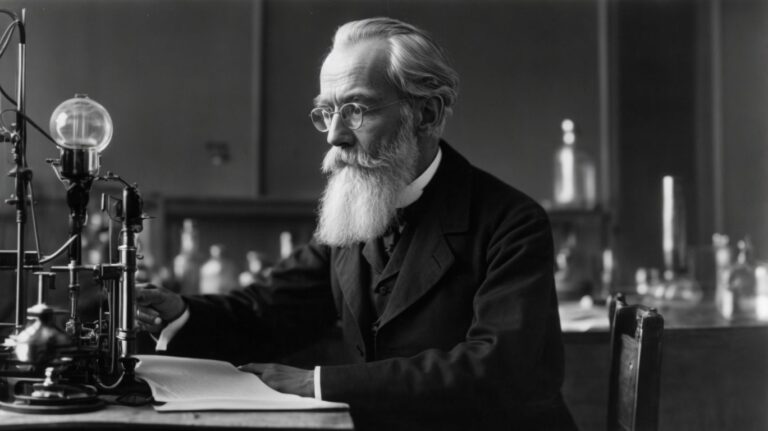Have you ever wondered about the origins of structuralism and its key concepts? In this article, we will delve into the founding figure of structuralism and explore the contributions they made to this school of thought.
We will also discuss the main differences between structuralism and other schools of thought, particularly in how it views language, communication, and social structures. We will examine the role of culture in structuralism and address the criticisms surrounding this theory.
We will explore the relevance of structuralism in today’s world and how it has influenced various fields of study such as linguistics, anthropology, psychology, literature, and philosophy. Join us on this journey as we uncover the roots of structuralism and its impact on the academic landscape.
Contents
- 1 What Is Structuralism?
- 2 Who Is The Founding Figure Of Structuralism?
- 3 What Are The Main Differences Between Structuralism And Other Schools Of Thought?
- 4 What Are The Criticisms Of Structuralism?
- 5 How Has Structuralism Influenced Other Fields Of Study?
- 6 Frequently Asked Questions
- 6.1 Who is considered the founding figure of Structuralism?
- 6.2 What are the main concepts of Structuralism?
- 6.3 How did Structuralism contribute to the study of language and literature?
- 6.4 What is the role of the unconscious in Structuralism?
- 6.5 How does Structuralism differ from other schools of thought?
- 6.6 What impact did Structuralism have on other fields outside of linguistics and literature?
What Is Structuralism?
Structuralism in psychology is a prominent school of thought that focuses on the examination of mental processes and consciousness through introspection, aiming to uncover the underlying structures that govern behavior and cultural phenomena.
What Are The Key Concepts Of Structuralism?
Key concepts of structuralism include the examination of mental processes, consciousness, and the use of introspection to uncover hidden rules and structures that govern behavior.
Structuralism, pioneered by early psychologists like Wilhelm Wundt and Edward Titchener, focused on understanding how the mind works by breaking down experiences into their fundamental components. Introspection, considered the primary method in structuralism, involved self-analysis to disclose the underlying mechanisms shaping thoughts and feelings. By scrutinizing immediate sensations and feelings, structuralists believed they could elucidate the structure of the mind.
Who Is The Founding Figure Of Structuralism?
Wilhelm Wundt is widely recognized as the founding figure of structuralism in psychology, paving the way for the systematic study of mental processes and introspection as essential components of psychological inquiry.
What Are The Contributions Of The Founding Figure To Structuralism?
Wilhelm Wundt’s contributions to structuralism include his pioneering work in establishing psychology as a scientific discipline focused on understanding mental processes through systematic introspection and observation.
Plus laying the foundation for the experimental study of the mind, Wundt developed innovative methods to analyze the human consciousness. His practice of introspection involved individuals reporting their thoughts and feelings while engaging in specific tasks, leading to a more comprehensive understanding of mental structures. Through his theories, Wundt emphasized the importance of breaking down complex experiences into basic elements to unravel the workings of the mind.
What Are The Main Differences Between Structuralism And Other Schools Of Thought?
Structuralism distinguishes itself from other schools of thought such as behaviorism, functionalism, Gestalt psychology, and phenomenology by its focus on analyzing underlying mental structures and processes through introspection rather than observable behaviors.
How Does Structuralism View Language And Communication?
Structuralism views language and communication as systems governed by underlying structures and rules, influenced by the works of Ferdinand de Saussure and Roman Jakobson in analyzing linguistic phenomena.
Through the lens of structuralism, language is seen as a complex web of interconnected signs and symbols, each carrying meaning within a larger system. Saussure’s concept of the linguistic sign, consisting of the signifier and the signified, highlights the arbitrariness of language and the importance of relationships between elements. Jakobson’s focus on the six functions of language illuminated how communication serves not only to convey information but also to express emotions, establish social bonds, and create aesthetic experiences.
What Is The Role Of Culture In Structuralism?
Culture plays a pivotal role in structuralism, as it examines societal norms, kinship systems, mythologies, and other cultural phenomena to uncover the deep structures and rules that underlie human thought and behavior.
Through the lens of structuralism, anthropologists delve into how cultural elements shape the collective consciousness of a society, influencing its members’ perceptions, beliefs, and actions. Structural analyses reveal interconnected patterns within cultures, highlighting the intricate web of meanings embedded in traditions and customs.
By scrutinizing the underlying frameworks of culture, scholars gain insights into the systematic organization of social practices and the symbolic significance attributed to various rituals and symbols. This holistic approach allows for a comprehensive understanding of the complexities of human societies, showing how cultural structures serve as scaffolds for human interactions and identity formation.
How Does Structuralism Analyze Social Structures?
Structuralism analyzes social structures by examining binary oppositions, cultural phenomena, and hidden rules within societies, drawing on the works of scholars such as Claude Levi-Strauss and Michel Foucault to uncover underlying patterns and structures.
Binary oppositions, a central concept in structuralist analysis, refer to the pairs of opposite terms like good/evil, nature/culture, or male/female that are thought to shape human understanding.
This method looks beyond the surface of social phenomena to identify deeper layers of meaning and significance, highlighting how seemingly unrelated elements can be interconnected in complex ways.
By exploring these underlying structures, structuralism aims to reveal the intricate web of relationships and power dynamics that govern societies, shedding light on the complexities of human behavior and culture.
What Are The Criticisms Of Structuralism?
Structuralism faces criticisms from post-structuralist perspectives, challenging its reliance on binary oppositions, cultural phenomena, and fixed structures in analyzing complex human experiences and cultural phenomena.
Is Structuralism Still Relevant Today?
The relevance of structuralism today is a topic of ongoing debate, with proponents highlighting its insights into human thought, hidden rules, and cultural structures, while critics argue for the need to adapt its methodologies to address contemporary complexities.
Structuralism, as a theoretical framework, emerged in the early 20th century and has had a profound influence on various disciplines, including linguistics, literature, anthropology, and psychology. Its core premise revolves around the idea that underlying structures govern human behavior and shape societies. By focusing on these underlying structures, structuralism seeks to uncover the hidden patterns and systems that define human thought and interactions.
One of the key strengths of structuralism lies in its ability to reveal the interconnectedness of seemingly disparate phenomena, emphasizing the importance of context and relationships in shaping meaning and identity.
How Has Structuralism Influenced Other Fields Of Study?
Structuralism has had a profound impact on various fields of study, influencing disciplines such as linguistics, anthropology, social anthropology, and cultural studies by providing frameworks to analyze human thought, cultural structures, and hidden rules.
Linguistics
In linguistics, structuralism has revolutionized the study of language by emphasizing the analysis of underlying structures, phonetic patterns, and semantic relationships, drawing on the works of scholars like Ferdinand de Saussure and Roman Jakobson.
Structuralism has had a profound impact on the field of linguistics, providing a framework through which language can be systematically studied and understood. By focusing on the underlying structures and patterns that govern language, linguists are able to delve deeper into the fundamental components of communication.
Through the lens of structuralism, phonetics is explored in terms of sound systems and speech production, shedding light on the intricacies of pronunciation and accent variations.
Within the realm of semantics, structuralist approaches analyze the meaning of words and symbols by examining their relational significance within a given language system. This methodological shift has allowed linguists to uncover the intricate web of meanings that underlie language usage and communication processes.
Anthropology
In anthropology, structuralism has reshaped the study of cultures and societies by examining the underlying structures, kinship systems, and mythologies that shape human interactions, inspired by the works of Claude Levi-Strauss and his analysis of cultural phenomena.
Structuralism in anthropology has had a profound impact on cultural studies, emphasizing the importance of looking beyond surface-level observations to uncover the hidden patterns and rules that govern societies. By focusing on the underlying structures and symbolic systems that underpin human behavior, anthropologists have been able to gain deeper insights into the intricacies of social organization and cultural practices.
Moreover, kinship analysis within the framework of structuralism has provided a valuable lens through which to understand the complexities of familial relationships and societal organization. Through this lens, researchers have been able to unravel the intricate web of kinship ties and social obligations that govern interactions within communities.
The application of structuralist principles to mythological interpretations has revolutionized the way anthropologists approach the study of myths and symbolism. By unpacking the underlying structures and symbolic meanings embedded in myths, researchers have been able to decode the cultural significance of these stories and their role in shaping collective beliefs and values.
Psychology
In psychology, structuralism has shaped the early foundations of the discipline through its focus on introspection, mental processes, and the systematic analysis of consciousness, championed by figures like Edward B. Titchener and his work on structural elements of the mind.
Structuralism, as a theoretical framework, aimed to break down mental experiences into their basic components, emphasizing the importance of understanding how these elements combine to form the overall conscious experience.
Edward B. Titchener, a student of Wilhelm Wundt, played a pivotal role in popularizing structuralism in America and refining the methods of introspection – a core component of this school of thought.
Through meticulous observation and analysis, Titchener sought to uncover the underlying structures of consciousness and cognition, paving the way for a more systematic approach to studying the human mind.
Literature
In literature, structuralism has influenced critical theory and literary analysis by exploring narrative structures, binary oppositions, and the deconstruction of texts, with figures like Jacques Derrida challenging conventional interpretations through post-structuralist perspectives.
Structuralism, as a method of analyzing literature, emphasizes the interconnectedness of different elements within a text, viewing them as part of a larger system rather than isolated entities. This approach has been instrumental in uncovering hidden meanings, underlying patterns, and power dynamics that shape narratives.
By deconstructing texts, structuralists aim to reveal the inherent tensions and contradictions present in language and culture, ultimately questioning the stability and coherence of meaning. The exploration of binary oppositions, such as male/female, presence/absence, and nature/culture, further highlights the complex interplay of opposing forces that drive narrative development.
Through the lens of structuralism, literary scholars have been able to delve deeper into the underlying structures that govern storytelling, shedding light on how texts are constructed and interpreted. This analytical framework challenges traditional notions of authorial intent and textual authority, paving the way for a more nuanced understanding of literary works.
Philosophy
In philosophy, structuralism has informed critical perspectives on knowledge, power structures, and cultural norms, with thinkers like Ferdinand de Saussure, Jacques Lacan, and Michel Foucault reshaping philosophical inquiry through their analyses of language, psychoanalysis, and social institutions.
One of the pivotal notions introduced by structuralism is the concept of language as a system of signs with relational meanings, rather than individual words with inherent definitions. This approach, championed by de Saussure, revolutionized linguistics and laid the foundation for semiotics as a study of signs and symbols.
Lacan, building upon Freudian psychoanalysis, extended the structuralist view to the realm of psychology, emphasizing how unconscious meanings and desires are structured through language and social frameworks, complicating traditional views on subjectivity and identity.
Foucault, through his archaeological and genealogical methods, exposed how power operates through knowledge systems, institutions, and discourses, demonstrating how seemingly neutral structures are imbued with power dynamics that regulate society and constrain individual agency.
Frequently Asked Questions
Who is considered the founding figure of Structuralism?
The founding figure of Structuralism is Swiss linguist Ferdinand de Saussure.
What are the main concepts of Structuralism?
The main concepts of Structuralism include binary oppositions, language as a system, and the idea that meaning is derived from relationships within a structure.
How did Structuralism contribute to the study of language and literature?
Structuralism paved the way for the study of language and literature by focusing on the underlying structures and systems that govern them, rather than individual works or authors.
What is the role of the unconscious in Structuralism?
According to Structuralist thought, the unconscious plays a major role in shaping our perceptions and understanding of the world through the use of symbols and underlying structures.
How does Structuralism differ from other schools of thought?
Structuralism differs from other schools of thought in its focus on structures and systems rather than individual elements, and its belief in the universality of these structures across cultures and disciplines.
What impact did Structuralism have on other fields outside of linguistics and literature?
Structuralism had a significant impact on fields such as anthropology, psychology, and philosophy, as well as the study of culture and society as a whole. Its emphasis on underlying structures and systems influenced many other schools of thought and continues to be relevant in modern academic discourse.




